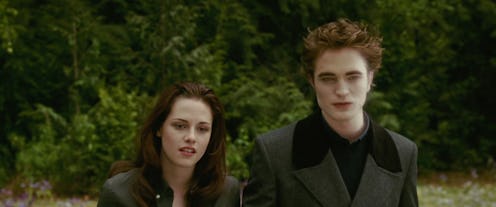Entertainment
Of Course Stevie Nicks Was Inspired By 'Twilight'

On Thursday, October 6, legendary singer and heroine of my heart Stevie Nicks appeared on The Late Late Show With James Corden and led a class in cool facts about her songs that you'd never heard about before. One particularly pub quiz-worthy fact arose: namely, that Stevie Nicks' song " Moonlight" was inspired by Twilight . Well, the Twilight sequel, The Twilight Saga: New Moon, anyways. James Corden's TV production staff had clearly thought this was a big enough deal to brief him so he would ask her about it, and it made sense thematically. After all, Twilight star Taylor Lautner was appearing alongside the Fleetwood Mac singer. Part of this left me a little out of sorts.
The very fact that Corden made it a talking point seemed a little... off, somehow. Sure, it's a fun fact. But it implies that it's incredibly surprising that indie-queen Nicks would be inspired by something like Twilight. It implies that there's a vast divide between something like Nicks' 2011 album In Your Dreams (on which the Twilight-inspired track, "Moonlight (A Vampire's Dream)" appears) and the Twilight series.
I'd assume this is because Nicks' music is seen as something we'll be listening to for decades — and, if her output as part of Fleetwood Mac is anything to go by, that's probably true — while Twilight's popularity is viewed as being a flash in the pan.
But Twilight has been undeniably popular, whether you refer to the statistics for either the books or the films. In 2013, Screenrant reported that over 100 million books had been sold and that the movies had grossed over $3.3 billion. I believe there's an obvious reason for the series' runaway popularity. I don't think the series has been so successful because of its originality, but because it combines topics that have fascinated audiences for time immemorial. If you condensed the series into themes, three topics dominate: vampires, love triangles, and being a teenager.
Vampires have been a surefire way to capture the public's imagination for centuries, making up a form of folklore that refused to die. When Bram Stoker published Dracula, he gave the world the form of a vampire that would be perpetuated relentlessly, with The Telegraph citing that "more than 1000 novels and 200 films" have been made about Dracula. And it's not just about numbers. When you think about some of the most popular shows or movies, whether True Blood or Buffy The Vampire Slayer, or, even Twilight, they all feature vampires. Meyer's decision to make the romantic interest of her heroine a vampire was a smart one — as pop culture history has shown, who doesn't like a story featuring vampires?
Love triangles are probably the only theme you could think of that are even more popular than vampires. Eric Berne, one of the analysts behind humanistic psychology, came up with the term "Let's You and Him Fight" to describe the conflictual aspect of a love triangle and considered "the psychology is essentially feminine. Because of its dramatic qualities, LYAHF is the basis of much of the world's literature, both good and bad."
Love triangles have appeared in everything from Romeo And Juliet (Romeo, Juliet, Paris) to The Great Gatsby (Daisy Buchanan, Tom Buchanan, Jay Gatsby) to A Tale Of Two Cities (Charles Darnay, Lucie Manette, Sidney Carton). It's no wonder that there's been such a rash of love triangles in young adult literature: audiences have been obsessed with the whole love triangle thing forever. So I'd argue a key aspect of Twilight's appeal is the ultra tense love triangle Stephanie Meyer sets up between Edward, Bella, and Jacob, which is even more powerful a part of its appeal than the supernatural aspects of the novels (and films). If you're not in possession of a high-functioning imagination, you might find it hard to relate to the vampire and werewolf threads. But anyone who's been a human being on Planet Earth can probably relate to liking more than one person at once or being jealous.
Finally, both the book and film's themes seem closely tied to Bella's age. Bella's growing interest in Edward marks a trajectory in which she becomes less close to her father and more interested in sex. Growing distance between you and your folks? Surging interest in pressing your lips against those of someone you're into? Doesn't sound like you need to have an affair with a vampire to identify with these. Novels about teens finding their own way have been all the rage since Salinger published The Catcher In The Rye (which went on to sell 60 million copies) in 1951 and have dominated our screens since James Dean appeared as the original misunderstood cinematic teen, Jim Stark, in Rebel Without A Cause in 1955.
Since then, we've seen teenagers figuring out the world in everything from My So-Called Life to Clarissa Explains It All. While Edward might have been born in 1901, it seems significant that he has the body of a 17-year-old boy. Physically, his uncontrollable lust for Bella (despite having a grasp on what making out with her will mean for her) puts him squarely in teenage territory. Ultimately, these teens might have supernatural powers, but, thematically, they're not so different from Angela Chase or Jim Stark.
All of which kind of makes you think: if anything, it's surprising that someone hasn't cited Twilight as an inspiration for a seriously dreamy love song sooner. After all, it checks all the boxes: the drama of vampires, the sex appeal of a love triangle, and the intrigue of being a teenager trying to figure out their own worldview.
Images: Summit Entertainment (2); The Late Late Show with James Corden; Andy Leo/Youtube (2); Giphy (2)